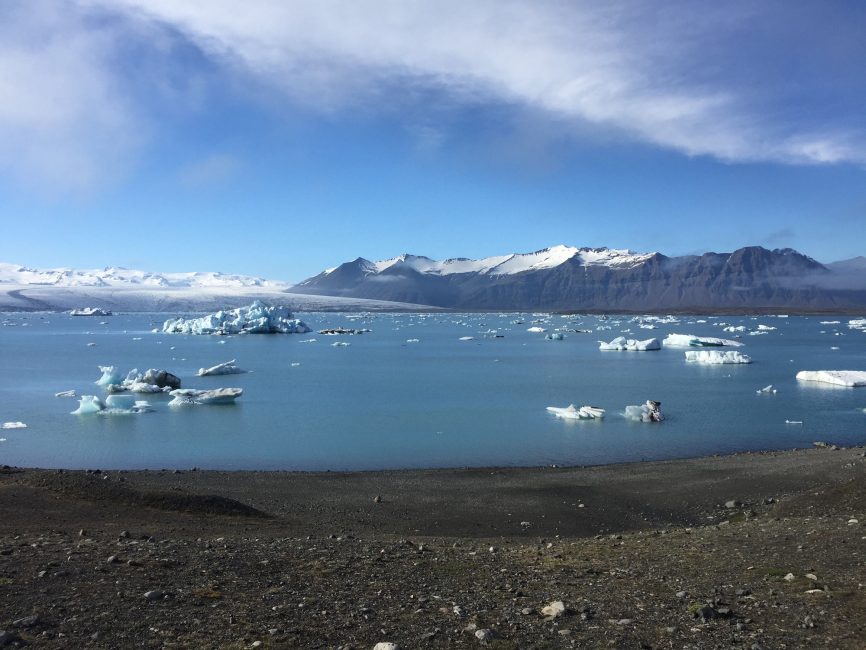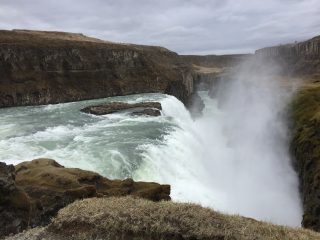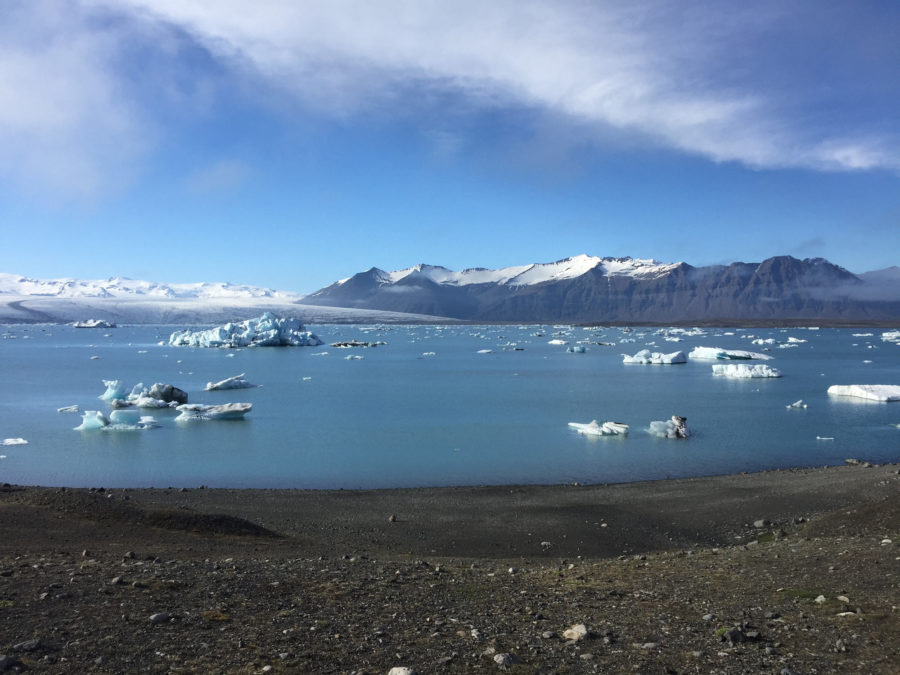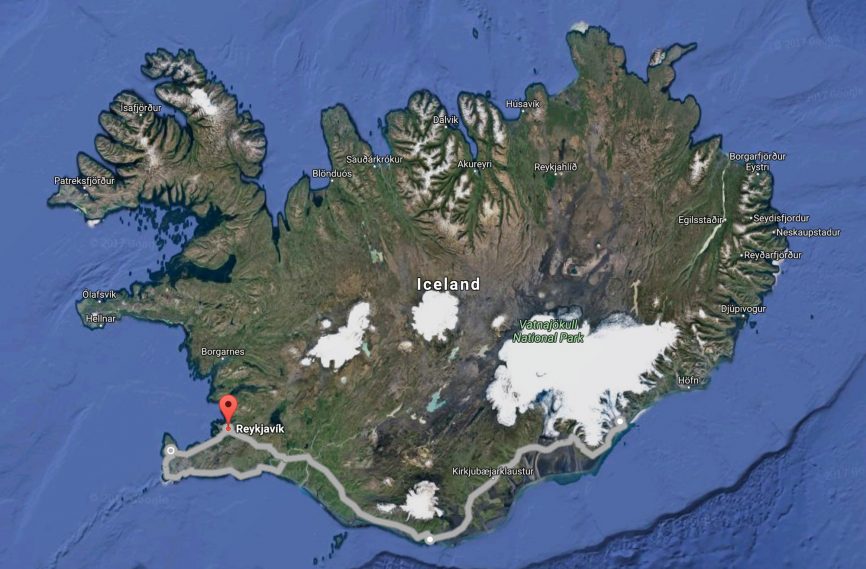My wife, Kim, and I just got back from a week abroad in Iceland — our first trip out of the country together since our Jamaican honeymoon and the first trip away from our toddler for more than a long weekend.

Fjallsárlón glacial lagoon
First of all, photos cannot capture the beauty that is Iceland. The mountains, the waterfalls, and the views are things you have to see in person. From the enormous glaciers to the east to the vibrant capital of Reykjavík in the west, Iceland is every bit what the guidebooks and travel blogs make it out to be.
For our trip, we wanted to be able to take in as much of Iceland as possible without losing the freedom to move at our own pace. As a result, we opted to rent a car at the airport, drive along the southern end of the country (staying just outside of the town of Vik), see the southeast end of the glacier field, then end the trip in Reykjavík.
Now that we’re back, I wanted to share a few things that I wish I had known before heading to Iceland.
1. Travel in Iceland is not like travel in the United States
Typically, my travel is for conferences, which are typically situated in or around major cities in the United States. Additionally, travel itineraries, accommodations, and activities are often coordinated by the conference organizers, leaving my trip planning down to “how early am I willing to fly out there?” and “are there any bars, restaurants, or other attractions I have to see while I’m there?” — oftentimes I’ll wait until I’m in the city with some time to kill before firing up Yelp and finding a good meal.
Kim, on the other hand, loves to plan; she’s not afraid to be spontaneous on a trip, but she’d rather have a list of good restaurants and attractions before stepping foot in the airport. She’s the one who suggested ordering a travel guide and a real, paper map. Kim was the one who put together a shared Google map of landmarks, attractions, and restaurants — not a strict itinerary, but a list of options that we could pick and choose from.
You know who has the better travel style for a trip like Iceland? I’ll give you a hint: it’s not me.

Gullfoss, one of the top waterfalls in Iceland.
Outside of the capital city of Reykjavík, Iceland is a string of small towns nestled between gorgeous landscapes and breathtaking natural features. It’s possible to go an hour or more between gas stations, and restaurants are dotted along the countryside, often tied to Iceland’s many guest houses.
Do yourself a favor and be more like Kim: pick out some restaurants and attractions you’d like to see, and give yourself options. Take note of where gas stations can be found, and try not to fall below half a tank.
2. Get a PIN on your credit card. Seriously.
Before leaving for Iceland, I upgraded my credit card from the Chase Freedom card I’d been using for years to the Chase Sapphire Preferred (my first card with an annual fee), which carries no foreign transaction fees and all sorts of great travel protections. While I was there, I asked the banker who was assisting me about putting a PIN on the credit card (a practice that’s much more common abroad than in the United States). The banker consulted with her manager, who assured me that while it was possible to add a PIN to the card, it was wholly unnecessary as the merchant would simply ask for a signed receipt instead.
Fast forward to the first time we got gas in Iceland, and I’m desperately trying to figure out how to pay for it. In Iceland, gas stations pre-authorize your card for a certain amount, then charge the card after you’ve pumped the gas. For example, if you authorized a purchase of 5000 kr (about $50 USD) worth of gas, the pump will automatically stop when the tank is full or you hit 5000 kr, whichever comes first (you’re not charged the full amount if you pump less than was authorized).
To prevent fraud, gas stations in Iceland require a PIN on the credit card in order to authorize at the pump; hitting “cancel” or “continue” — common ways to bypass PIN prompts — without a PIN would yield an error and failed transaction. Without a PIN on my card, I was forced to head inside the station (meaning I would have been S.O.L. had I needed to fill up after-hours) to purchase a pre-paid fuel card that I could then use outside at the pump. It was only the third and final time refueling (on our way back to the airport to return the rental car) that I was able to have the station attendant unlock the pump and let me pay via card after refueling.
3. A data plan makes driving so much easier
Kim and I both have iPhones (a 6S and a 6, respectively) on Verizon, and wanted to make sure we were able to keep in touch with friends and family while we were overseas. Fortunately, our phones are both compatible with Icelandic networks (Verizon customers can check their device compatibility here), so the only question to answer was how much data we needed.
On Verizon, there are two main travel options: TravelPass ($10/day to access your existing calling/data plan in Iceland) or the International 100 Talk, Text, and Data ($40/month for 100 minutes, 100 texts, and 100MB of data usage). We knew that wi-fi was very common in Iceland, so we both opted for the 100 plan; looking back, 100MB of data was far too little.
On our first day into the trip, we were getting in touch with Verizon and upgrading my plan to the TravelPass; $10/day is pretty steep, but having access to my full data plan was a huge help. In all, I ended up using about 200MB worth of data in the week we were in Iceland, most of that going towards Google Maps; the turn-by-turn navigation helped keep us on track, especially on the often poorly-labeled roads (the language barrier didn’t help, either).
My best recommendation: $10 is about the price of a beer in Iceland, so it’s worth having sufficient data and knowing you won’t end up lost in the middle of nowhere. If we were to go again, we’d put the TravelPass on one phone and leave the other in airplane mode, going wi-fi only. Of course, we’d end up paying international roaming if we ended up using the second phone, but it’s still nice to have it in case of an emergency.
4. Parking in Reykjavík is best left to the locals
The last stop on our trip was Reykjavík, the largest city and capital of Iceland. We were staying right in the heart of the city (literally around the block from the world-famous Bæjarins Beztu Pylsur hot dog stand). Google Maps got us into the city without any problem, but after circling the city center a few times, Kim ended up hopping out, heading to the hotel, and asking where the heck we should park.
As it turns out, it’s not uncommon for hotels in the city center to not have parking nor a valet option (something that would have caused us to reconsider booking) — instead, we were left to fend for ourselves to find a spot that wouldn’t require us to move the car by 8am the next morning.
We were able to find a spot on the street several blocks from our hotel, where we left the car for the majority of our time in Reykjavík. The night before we left, we moved the car in front of the hotel and paid the remainder of the evening on the paid parking, knowing we’d be leaving for the airport by 7am the next morning.
If you don’t have to drive in Iceland (for example, you’re taking a tour bus to see the sights), I’d recommend avoiding a rental car. Busses run between the airport in Keflavík and Reykjavík, and the less you have to worry about parking the better. That being said, driving in the city was no big deal (save for the tourists who were clueless when it came to traffic circles).
5. Food and drink are “expensive”
Kim and I are both rather frugal, but we’ve looked back with regret on vacations where we were frugal to the point of hindering our experience (e.g. “we’ve heard that restaurant is amazing, but $35/person? No way, José!”). This trip, we promised ourselves that we’d keep and open mind and not be too price-sensitive; after all, this was our first big vacation in years, and possibly the only time we’d ever be in Iceland.
On our way to Iceland, we spent a day in Boston (Iceland Air doesn’t touch John Glenn International Airport here in Columbus), where we were shocked at food prices. $12 for a beer? $18 for a burger? Unfortunately, this was pretty par for the course with the rest of our trip; Iceland, being an island nation with a climate that isn’t particularly conducive to farming, has to import a fair amount of its food (or grow it in greenhouses). As a result, $18 burgers, $10-12 beers, and even $15 salads were not uncommon; expensive when compared to many restaurants state-side, but pretty typical for people living in cities like New York, Boston, or San Francisco.
I will say this, though: the majority of meals we had in Iceland were fantastic. Kim claims the chicken breast at Suður-Vík was the best she’s ever had, and the most “disappointing” meal we had was at a pretty average pub in Reykjavík. Along the Golden Circle, we discovered Friðheimar, which operates its restaurant inside the greenhouse, thus combining two of Kim’s favorite things: delicious food and gardening.
6. “Iceland Loves Coffee” is relative
Plenty of travel blogs like to talk about Iceland’s love of coffee and its current “Coffee Renaissance”, but from what I could tell it’s more akin to the self-proclaimed “coffee snob” who loves Starbucks or the college student who “only drinks craft beer, like Sam Adams’ Boston Lager” — both are a step above the common, garden-variety brands like Folger’s or Budweiser.
The majority of the country seems to use fully-automated grind machines, not unlike the waiting room of my local car dealership. The typical brew was dull and uninspiring, served in a small, 80z cup for about $4 USD (which may or may not include a refill). Even some of the places that were purported to have the best coffee were often serving regular coffee out of airpots rather than offering freshly-brewed options, which was disheartening.
There are a number of micro-roasters in Iceland, but I didn’t get a chance to visit many of them. The best cup of the entire trip, however, was a Guatemalan pour-over from Te & Kaffi’s Micro Roast café; the preparation was meticulous, the flavors present yet well-rounded, and the finish warmed your chest. I had hoped to return the next morning for a siphon coffee (a brewing method I haven’t seen practiced here in Columbus), but sadly the coffee shops typically don’t open in Reykjavík until 8am (and we had to leave for the airport by 7am).
Wrapping up
Overall, Iceland was a fantastic vacation destination and a place Kim’s already aching to return to. The people are friendly, the sights breathtaking, and the food was pretty great, too. If Iceland isn’t already on your radar for a future vacation, I’d urge you to consider it — especially now that you know six things I didn’t when I first landed!





Leave a Reply